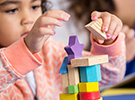One Fish, Red Fish
In this lesson, children will sort, count and record piles of different-colored Goldfish crackers.
Lesson for:
Toddlers/Preschoolers
(See Step 5: Adapt lesson for toddlers or preschoolers.)
Content Area:
Algebra
Learning Goals:
This lesson will help toddlers and preschoolers meet the following educational standards:
- Understand numbers, ways of representing numbers, relationships among numbers and number systems
- Understand patterns, relations and functions
Learning Targets:
After this lesson, toddlers and preschoolers should be more proficient at:
- Counting with understanding and recognizing “how many” in sets of objects
- Sorting, classifying and ordering objects by size, number and other properties

One Fish, Red Fish
Lesson plan for toddlers/preschoolers
Step 1: Gather materials.
- The book, One Fish, Two Fish, Red Fish, Blue Fish by Dr. Seuss
- Fish recording sheet (five columns of fish for the different colors of the fish crackers and space below each column to write the total number of fish of each color)
Note: Small parts pose a choking hazard and are not appropriate for children age five or under. Be sure to choose lesson materials that meet safety requirements.
Step 2: Introduce activity.
- Children place one fish cracker on each fish on the recording sheet. Have the children color in the fish on the recording sheet so that it is the same color as the cracker. When they are done placing the fish in their piles, they count how many they have of each color and write the number in the space at the bottom of the sheet.
- When the children are done sorting, counting and tallying their goldfish, bring them together to compare answers. If you use the entire carton, make a classroom graph combining all of the children’s results.
Step 3: Engage children in lesson activities.
- The children can tally up the totals for each fish cracker color and get a grand total of all of the fish crackers that they counted and sorted
- Have the children sort the goldfish by more than one attribute, such as size and color
Additional Extensions
- Work with addition. Have the children combine two colors and add them together. Say: “If you have three green and five yellow goldfish, how many goldfish do you have altogether?”
Step 4: Vocabulary.
- Count: To identify the amount of something by number
- Sort: To separate items according to a given attribute
- Compare: To estimate, measure or note the similarity or dissimilarity between two or more things
- Tally: To use marks to record counting (e.g., to count by fives to get the total)
- Add: Increase in amount or number
Step 5: Adapt lesson for toddlers or preschoolers.
Adapt Lesson for Toddlers
Toddlers may:
- Not yet have one-to-one correspondence
Child care providers may:
- Just have the children sort the goldfish into colors
Adapt Lesson for Preschoolers
Preschoolers may:
- Count from 0–20
- Sort by a common attribute
Child care providers may:
- Have the children add the results of different colors together to get the total number of fish that they counted and sorted
- Have the children sort the goldfish by more than one attribute, such as size and color
Suggested Books
- Math Counts: Sorting by Henry Arthur Pluckrose (CT: Children’s Press, 1995)
- Counting Kisses: A Kiss & Read Book by Karen Katz (New York: Little Simon, 2003)
- Pepperidge Farm Goldfish Counting Fun Book by Barbara Barbieri McGrath (New York: HarperFestival, 2000)
Music and Movement
Outdoor Connections
The children can collect, sort and categorize autumn leaves and then create pattens with different types of leaves. Glue the leaves onto construction paper in the patterns that the children have created. They can create patterns by color, type of leaf (maple, oak) or size of leaf.
Comment on this lesson